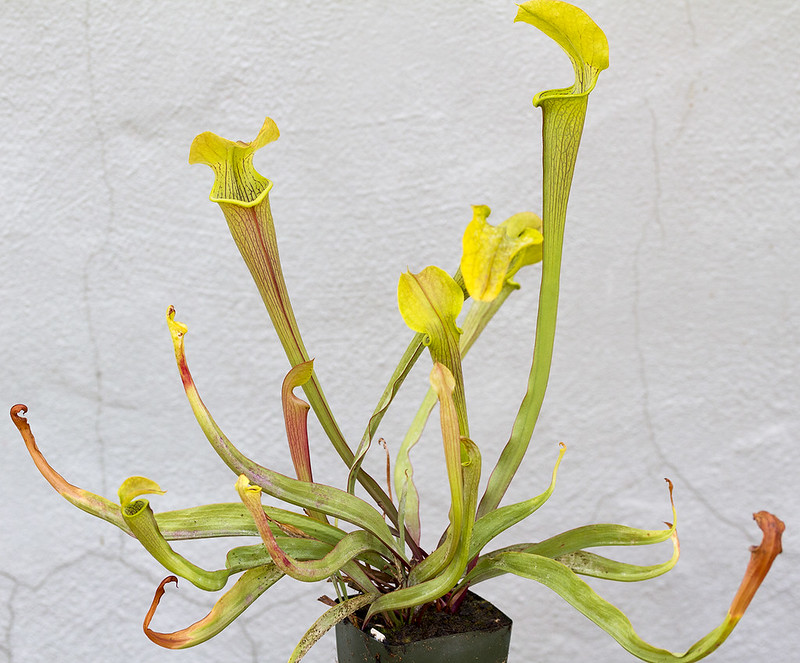Post by Clue on Aug 6, 2022 16:09:47 GMT -5
Not a lot's been posted about S. alabamensis ssp. alabamensis, rightfully so because it's covered by the Endangered Species Act which prohibits interstate commerce here in the USA. I thought I'd post some observations of my three S. alabamensis from the ICPS's 2003 distribution since I have a plant from each location. For more on these locations, Barry Rice's FAQ has brief descriptions here. I can't say whether these plants are typical of each location, but I think they are very good representations of how remarkably diverse this species is.

Left to right: S. alabamensis ICPS locations AL001, AL002, and AL003. Photo taken this morning, August 6. The most well-known feature of S. alabamensis is that the most robust pitchers are made in the fall and springtime growth is quite spindly, even in full sunlight. These weak spring pitchers are obvious in AL002 and AL003, which haven't begun making fall pitchers yet. In contrast, AL001 has already started its late season pitchers, and while some of its spring pitchers have an expanded ala, their habit is much more upright. AL001 runs on a shifted timetable compared to the other two - not only the late-season pitcher flush, but it also flowers about two weeks earlier.


AL001 in flower, early April 2022, demonstrating its uniquely upright and relatively robust spring pitchers. AL001 in fruit, August 2022, with most spring pitchers removed and late season flush underway.


AL002, early May 2022 and August 2022. The pitcher habit is particularly decumbent, even in the late season flush which can be seen in this photo from early September last year:




AL003, early May 2022 and August 2022 (before and after thinning some spring pitchers). I think of this plant as the archetypal S. alabamensis; neither as oddly robust as the S. alata-esque AL001 nor as contorted as the gangly AL002 in its fall growth. Last year's fall flush is a good example (September 2021):


Group shot again after thinning spring pitchers. As far as special cultivation notes, I've noticed that this species is especially attractive to pests (mealybugs and thrips in my experience). As high light as possible, thinning spring pitchers, and limiting plant density are all helpful steps. S. alabamensis has a very strong clumping habit, more so than other taxa in the S. rubra complex for me, so thinning growth points is also very important to keep airflow and plant health high. While S. alabamensis rhizomes at vegetative maturity are much larger than any S. rubra, I've had best success keeping this species in quite small pots. My casual observation is that the roots are not particularly robust, so large/deep pots have become anoxic before the roots could get deep into the peat to keep it loose. Unlike S. leucophylla, whose late season performance is heavily influenced by the environment, late season S. alabamensis seems to be quite programmatic (akin to midsummer phyllodia production of S. oreophila).

Left to right: S. alabamensis ICPS locations AL001, AL002, and AL003. Photo taken this morning, August 6. The most well-known feature of S. alabamensis is that the most robust pitchers are made in the fall and springtime growth is quite spindly, even in full sunlight. These weak spring pitchers are obvious in AL002 and AL003, which haven't begun making fall pitchers yet. In contrast, AL001 has already started its late season pitchers, and while some of its spring pitchers have an expanded ala, their habit is much more upright. AL001 runs on a shifted timetable compared to the other two - not only the late-season pitcher flush, but it also flowers about two weeks earlier.


AL001 in flower, early April 2022, demonstrating its uniquely upright and relatively robust spring pitchers. AL001 in fruit, August 2022, with most spring pitchers removed and late season flush underway.


AL002, early May 2022 and August 2022. The pitcher habit is particularly decumbent, even in the late season flush which can be seen in this photo from early September last year:




AL003, early May 2022 and August 2022 (before and after thinning some spring pitchers). I think of this plant as the archetypal S. alabamensis; neither as oddly robust as the S. alata-esque AL001 nor as contorted as the gangly AL002 in its fall growth. Last year's fall flush is a good example (September 2021):


Group shot again after thinning spring pitchers. As far as special cultivation notes, I've noticed that this species is especially attractive to pests (mealybugs and thrips in my experience). As high light as possible, thinning spring pitchers, and limiting plant density are all helpful steps. S. alabamensis has a very strong clumping habit, more so than other taxa in the S. rubra complex for me, so thinning growth points is also very important to keep airflow and plant health high. While S. alabamensis rhizomes at vegetative maturity are much larger than any S. rubra, I've had best success keeping this species in quite small pots. My casual observation is that the roots are not particularly robust, so large/deep pots have become anoxic before the roots could get deep into the peat to keep it loose. Unlike S. leucophylla, whose late season performance is heavily influenced by the environment, late season S. alabamensis seems to be quite programmatic (akin to midsummer phyllodia production of S. oreophila).












